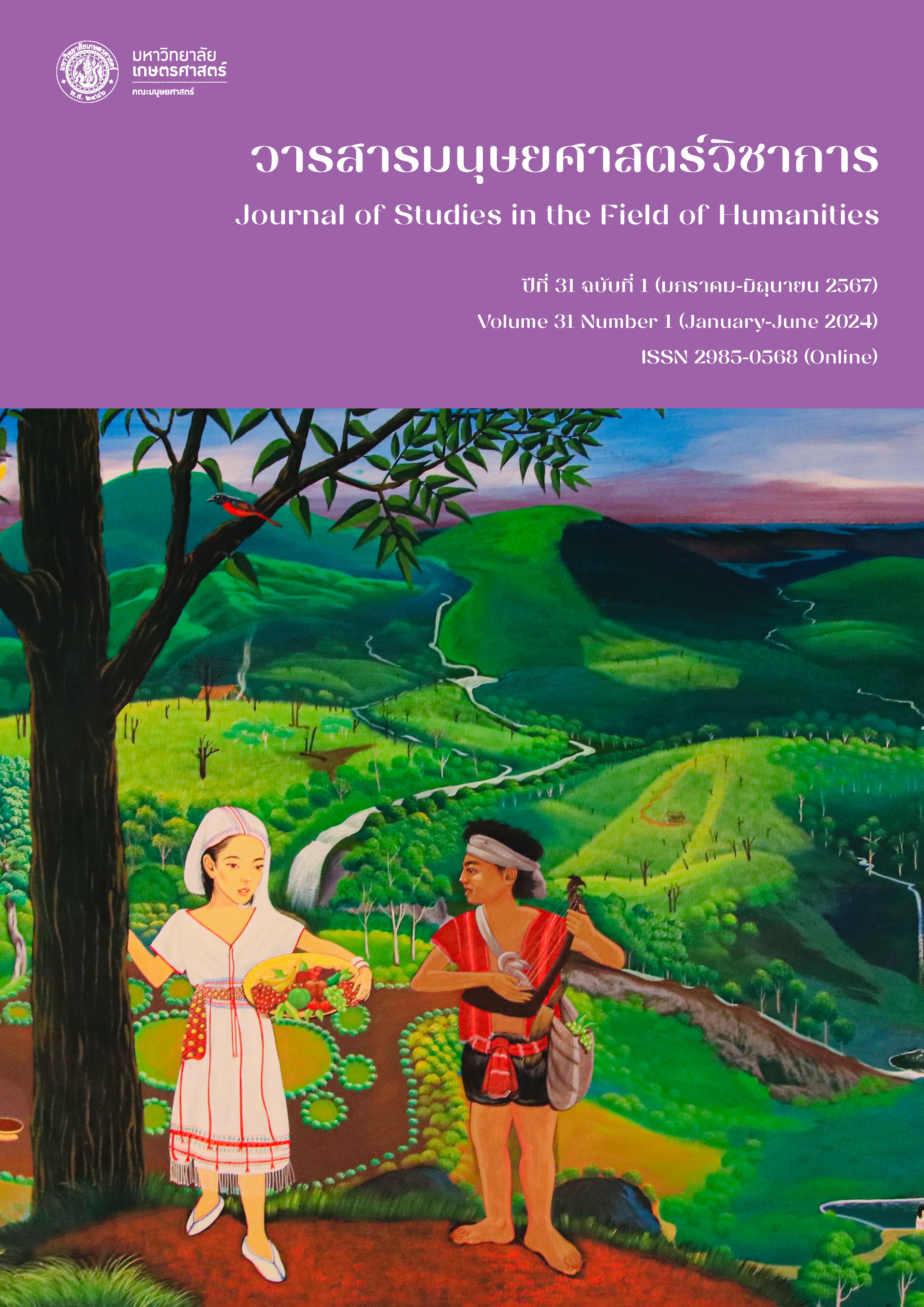Capturing the Lessons Learned from Music for the Elderly Health Promotion: asame A Case Study of Pattana Sukk
Main Article Content
Abstract
This research aims to capture the lessons learned from music for the elderly health promotion through a case study of Pattana Sukkasame. The research method was interviewing and observing four informant groups assigned by purposive sampling. These 211 informants are 1) Pattana Sukkasame, 2) eight conductors who have been trained by Pattana Sukkasame, 3) two hundred elderly people who attend music activities, and 4) two people who have been involved in the research project. The results of this research can be used by related organizations to create policies and guidelines for music for the elderly health promotion in Thailand.
The results show that 1) the Phayao Honghein Poosoong-ayoo (PHP), the school for the elderly, is only a symbolic name that does not represent an actual physical school site. The ‘school’ objective is to promote mental and physical health, and good living in society with value, honor, and happiness for the elderly; 2) the lessons learned from Pattana Sukkasame's music activities can be explained by using Professor Dr. Elizabeth Steiner's educational theory in the following ways: 1) the teacher is a conductor who must appreciate music and people; 2) students or the elderly are not required to have music background, and having interest in music is enough to join the class; 3) the curriculum focuses on the elderly health promotion, i.e.promoting emotional and social well-being, as well as memory. The three basic principles used for teaching are Kodaly's hand signs, Dusdi Paribatra Na Ayudhya’s music teaching concepts and health promotion awareness; and 4) the activities are based on the learning by doing approach that are related to the elderly's needs and interests. Authentic assessment has been used in observation of angklung playing skills, class participation and happiness.
Article Details

This work is licensed under a Creative Commons Attribution-NonCommercial-NoDerivatives 4.0 International License.
References
กรมสุขภาพจิต. (2563). ก้าวย่างของประเทศไทย สู่ ‘สังคมผู้สูงอายุ’ อย่างสมบูรณ์แบบ. สืบค้นจาก https://www.dmh.go.th/news-dmh/view.asp?id=30476.
ชลัช สุภาพกุล และคณะ. (2559). การให้ความหมาย ที่มาของความหมาย และรูปแบบของการดำเนินกิจกรรมของจิตอาสาที่เป็นกลุ่มผู้สูงอายุเล่นดนตรีเพื่อผู้ป่วยในโรงพยาบาล. Veridian E-Journal Silpakorn University (Humanities, Social Science and Arts), 9(1), 516-528.
ช่อผกา กิระพล, และสิริชัย ดีเลิศ. (2560). ทัศนคติและมุมมองการสร้างความสุขจากดนตรีของผู้สูงอายุ ในพื้นที่กรุงเทพมหานครและปริมณฑล. Veridian E-Journal Silpakorn University (Humanities, Social Science and Arts), 10(3), 363-373.
ณรุทธ์ สุทธจิตต์. (2541). จิตวิทยาการสอนดนตรี. กรุงเทพฯ: จุฬาลงกรณ์มหาวิทยาลัย.
ณรุทธ์ สุทธจิตต์. (2561). ดนตรีศึกษา หลักการและสาระสำคัญ (พิมพ์ครั้งที่ 10). กรุงเทพฯ: จุฬาลงกรณ์มหาวิทยาลัย.
บุษกร บิณฑสันต์ (2553). ดนตรีบำบัด. กรุงเทพฯ: จุฬาลงกรณ์มหาวิทยาลัย.
พัฒนา สุขเกษม. (2560, 23 กันยายน). ผู้บริหารโฮงเฮียนผู้สูงอายุพะเยา. [บทสัมภาษณ์].
พัฒนา สุขเกษม. (2561, 13 มกราคม). ผู้บริหารโฮงเฮียนผู้สูงอายุพะเยา. [บทสัมภาษณ์].
พัฒนา สุขเกษม. (2561, 31 มีนาคม). ผู้บริหารโฮงเฮียนผู้สูงอายุพะเยา. [บทสัมภาษณ์].
พัฒนา สุขเกษม. (2561, 6 พฤษภาคม). ผู้บริหารโฮงเฮียนผู้สูงอายุพะเยา. [บทสัมภาษณ์].
แพง ชินพงศ์. (2551). ดนตรีเพิ่มพลังสมอง. กรุงเทพฯ: แฮปปี้แฟมิลี.
ภูริพงษ์ เจริญแพทย์, และทัศนา ชูวรรธนะปกรณ์. (2559). ผลของโปรแกรมการใช้ดนตรีบำบัดร่วมกับการสนับสนุนทางสังคมต่อภาวะซึมเศร้าในผู้สูงอายุโรคพาร์กินสัน. วารสารสภาการพยาบาล, 31(1), 44-55.
วิภาสินี เมาลานนท์. (2555). ศึกษาแนวทางทางการตลาดและการดำเนินธุรกิจโรงเรียนดนตรีสำหรับผู้สูงอายุ (วิทยานิพนธ์มหาบัณฑิต). มหาวิทยาลัยศิลปากร, กรุงเทพฯ.
ศุภวัลย์ พลายน้อย. (2549). บทเรียนของการถอดบทเรียนในการจัดการความรู้ภาคประชาสังคม สนับสนุนโดยสำนักงานกองทุนสนับสนุนการสร้างเสริมสุขภาพ (สสส.) สถาบันชุมชนท้องถิ่นพัฒนา (LDI). กรุงเทพฯ: พี.เอ.ลีฟวิ่ง.
ศูนย์ข้อมูลกลางทางวัฒนธรรม กระทรวงวัฒนธรรม. (2555). โฮงเฮียนผู้สูงอายุ. สืบค้นจาก http://www.m-culture.in.th/album/157505/js/.
สภาวัฒนธรรมจังหวัดพะเยา. (2560). แบบเสนอข้อมูลประวัติและผลงาน เพื่อประกาศเชิดชูเกียรติเป็นศิลปินแห่งชาติ สาขาศิลปะการแสดง กลุ่มดนตรีไทยและนาฏศิลป์ไทย. พะเยา: สภาวัฒนธรรมจังหวัดพะเยา.
สำนักงานกองทุนสนับสนุนการสร้างเสริมสุขภาพ. (2560). รู้จัก สสส. สืบค้นจาก http://www.thaihealth.or.th/Aboutus.html.
สำนักงานคณะกรรมการการอุดมศึกษา. (2555). การออกแบบการเรียนรู้ที่เป็นสากล (Universa Design for Learning). กรุงเทพ: สำนักงานคณะกรรมการการอุดมศึกษา สำนักส่งเสริมและพัฒนาศักยภาพนักศึกษา กลุ่มส่งเสริมการเรียนรู้ประสบการณ์กับชุมชน.
สำนักวิชาการและมาตรฐานการศึกษา สำนักงานคณะกรรมการการศึกษาขั้นพื้นฐาน กระทรวงศึกษาธิการ. (2553). แนวทางการบริหารจัดการหลักสูตร ตามหลักสูตรแกนกลางการศึกษาขั้นพื้นฐาน พุทธศักราช 2551 (พิมพ์ครั้งที่ 2). กรุงเทพฯ: ชุมนุมสหกรณ์การเกษตรแห่งประเทศไทย.
หมอชาวบ้าน. (2553). การบริหารสมอง (Brain Activation). สืบค้นจาก https://www.doctor.or.th/article/detail/10955.
อุดม เพชรสังหาร. (2553). ดนตรีกับโรคความจำเสื่อมในผู้สูงอายุ. โลกวันนี้วันสุข, 6(268), 37.
Belland, L., Rivera-Reyes, L., & Hwang, U. (2017). Using music to reduce anxiety among older adults in the emergency department: A randomized pilot study. Journal of Integrative Medicine, 15(6), 450-455.
Carefect Home Health Care Services. (2012). The benefits of music therapy for seniors with Alzheimer’s. Retrieved from http://www.carefecthomecareservices .com/ blog/the-benefits-of-music- therapy-for-seniors-with-alzheimers.
Gallego, M. G., & García, J. G. (2017). Music therapy and Alzheimer's disease: Cognitive, psychological, and behavioural effects. Neurología (English Edition), 32(5), 300-308.
Knowles, M. (1984). Andragogy in action. San Francisco: Jossey-Bass.
Knowles M., Holton E. F., & Swanson, R. A. (2005). The adult learner. Burlington, MA: Elsevier Inc.
Posey, A. (n.d.). Universal Design for Learning (UDL): A teacher’s guide. Retrieved from https://www.understood.org/en/school-learning/for-educators/universal-design-for-learning /understanding-universal-design-for learning.
Steiner, E. (1988). Methodology of theory building. Sydney: Educology Research Associates.
Wall, M., & Duffy, A. (2010). The effects of music therapy for older people with dementia. British Journal of Nursing. 19(2), 108-113.

